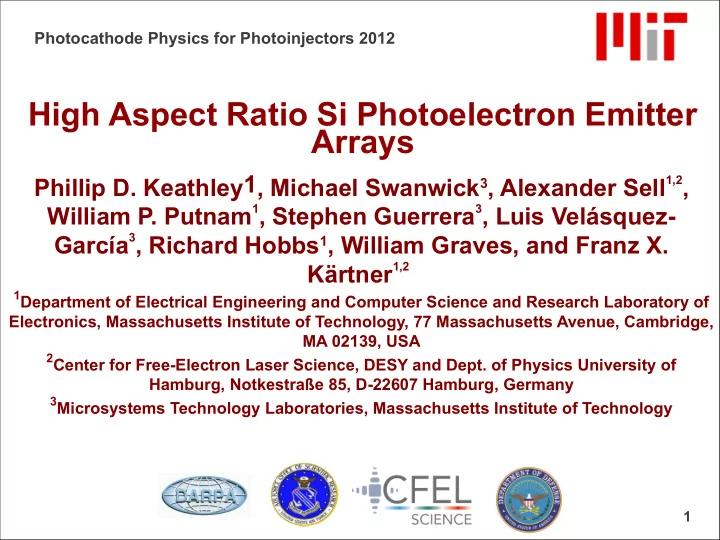

Photocathode Physics for Photoinjectors 2012 High Aspect Ratio Si Photoelectron Emitter Arrays Phillip D. Keathley1, Michael Swanwick 3 , Alexander Sell 1,2 , 1 , Stephen Guerrera 3 , Luis Velásquez- William P. Putnam 3 , Richard Hobbs 1 , William Graves, and Franz X. García 1,2 Kärtner 1 Department of Electrical Engineering and Computer Science and Research Laboratory of Electronics, Massachusetts Institute of Technology, 77 Massachusetts Avenue, Cambridge, MA 02139, USA 2 Center for Free-Electron Laser Science, DESY and Dept. of Physics University of Hamburg, Notkestraße 85, D-22607 Hamburg, Germany 3 Microsystems Technology Laboratories, Massachusetts Institute of Technology 1
Why Nano-Tip Electron Emitters? Localized field enhancement → prevents damage from high input energies Tunneling regime accessible via optical excitation → intense attosecond electron bursts Localized emission → lower emittance from individual tips Structured electron beams → emittance exchange 1 15 nm 10 µm 500 nm 1 W. S. Graves, F. X. Kaertner, D. E. Moncton, and P. Piot, arXiv:1202.0318, Feb. 2012.
Experimental Setup for Photo-Electron Energy Characterization 10 µm ~6° n-doped Si tips end radius of ~10 nm Native SiO 2 not removed
Initial Observations First exposure to low incident pulse energy, < 0.7 μJ → No change in spectra Second exposure to high incident pulse energy, > 1.0 μJ → Systematic changes. Induces: ● Red Shift ● Onset of plateau Repeat low energy tests
Energy Spectra After Anneals – 0.6 μJ
Power Scaling of Energy Spectra Main peak almost fixed with increased incident energy Higher energy plateau extends with increased intensity No significant change in main peak width
Total Current Yield – After Total Anneal
Possible Mechanisms Left & Top Right : Image taken from R. Bormann, M. Gulde, A. Weismann, S. V. Yalunin, and C. Ropers, Phys. Rev. Lett., vol. 105, no. 14, p. 147601, 2010. Red curve is SFA of photoemission from step potential with work function ~5eV. Calculation based on their results. Bottom Right: Example of potential barrier bending. Taken from P. Hommelhoff, et al., Phys. Rev. Lett., vol. 97, no. 24, p. 247402, Dec. 2006.
Modeling the Emission Process The Keldysh parameter, γ , is figure of merit for determining emission regime – tunneling or multi-photon Transition to tunneling regime when 1 : Where is the ponderomotive potential. Transition point measured leads to enhancement of 10-14. At a 12x field enhancement, with 0.6 μJ incident energy we have 1 R. Bormann, M. Gulde, A. Weismann, S. V. Yalunin, and C. Ropers, Phys. Rev. Lett., vol. 105, no. 14, p. 147601, 2010.
Modeling the Emission Process Given tunneling regime, we have a 3-step process for each electron orbit beginning at t 0 (similar to 1 ): Electron emitted at time t 0 , with tunneling rate Г (Fowler-Nordheim emission), at the tunnel exit Strong-field accelerates the electron (classical mechanics) When electron returns to z=0, elastically scatter off of tip Each orbit final momentum has weight Г(t 0 ) when calculating energy spectra 1 G. Herink, D. R. Solli, M. Gulde, and C. Ropers, Nature, vol. 483, no. 7388, pp. 190–193, Mar. 2012.
Modeling the Emission Process Given tunneling regime, we have a 3- step process for each electron orbit beginning at t 0 (similar to 1 ): Electron emitted at time t 0 , with tunneling rate Г (Fowler-Nordheim emission), at the tunnel exit Strong-field accelerates the electron (classical mechanics) When electron returns to z=0, elastically scatter off of tip Each orbit final momentum has weight Г(t 0 ) when calculating energy spectra 1 G. Herink, D. R. Solli, M. Gulde, and C. Ropers, Nature, vol. 483, no. 7388, pp. 190–193, Mar. 2012.
Modeling the Emission Process Given tunneling regime, we have a 3-step process for each electron orbit beginning at t 0 (similar to 1 ): Electron emitted at time t 0 , with tunneling rate Г (Fowler-Nordheim emission), at the tunnel exit Strong-field accelerates the electron (classical mechanics) When electron returns to z=0, elastically scatter off of tip Each orbit final momentum has weight Г(t 0 ) when calculating energy spectra 1 G. Herink, D. R. Solli, M. Gulde, and C. Ropers, Nature, vol. 483, no. 7388, pp. 190–193, Mar. 2012.
Model Results and Comparison To Experiment Experimental Results Model Results
Total Current Characterization ● Similar structures ● High aspect ratio ● 10 nm tip radius of curvature ● Same laser parameters, slightly higher rep-rate ● 3 kHz vs. 1 kHz ● Preparation ● HF dipped before testing
Total Current Characterization
Effect of Bias Voltage – 7 μJ
Summary Photo-electron from Si tips with native oxide studied Laser-induced annealing process observed through spectral changes Broad plateau observed extending more than 10 eV beyond main spectral peak Red shift of main spectral peak Theoretical model introduced Tunneling regime modeled through three step “simple-man” model Reproduces Onset of plateau → due to electron re-scattering Total Electron Yield Characterization 0.66 pC/bunch Effective QE = 1.5x10 -7
Future Directions Better modeling of field profiles around structure Quantitatively improved simulations 3D Model of electron emission → full emittance model Transverse profile measurements Emittance measurements for electron source applications Engineering FEA tip designs Prevent re-scattering → high flux monochromatic electron beams Temporal Characterization Verify sub-cycle duration of emitted electrons at surface
Recommend
More recommend